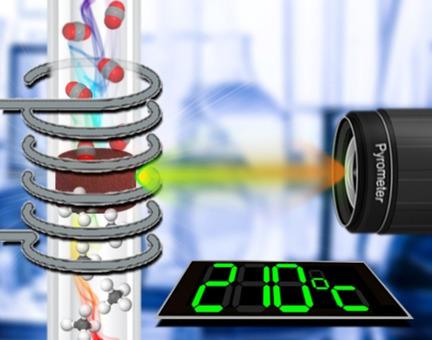当前位置:
X-MOL 学术
›
ChemSusChem
›
论文详情
Our official English website, www.x-mol.net, welcomes your feedback! (Note: you will need to create a separate account there.)
Highly Nickel-Loaded γ-Alumina Composites for a Radiofrequency-Heated, Low-Temperature CO2 Methanation Scheme.
ChemSusChem ( IF 8.4 ) Pub Date : 2020-09-01 , DOI: 10.1002/cssc.202001885 Wei Wang 1 , Cuong Duong-Viet 1 , Giulia Tuci 2 , Yuefeng Liu 3 , Andrea Rossin 2 , Lapo Luconi 2 , Jean-Mario Nhut 1 , Lam Nguyen-Dinh 4 , Giuliano Giambastiani 1, 2, 5 , Cuong Pham-Huu 1
ChemSusChem ( IF 8.4 ) Pub Date : 2020-09-01 , DOI: 10.1002/cssc.202001885 Wei Wang 1 , Cuong Duong-Viet 1 , Giulia Tuci 2 , Yuefeng Liu 3 , Andrea Rossin 2 , Lapo Luconi 2 , Jean-Mario Nhut 1 , Lam Nguyen-Dinh 4 , Giuliano Giambastiani 1, 2, 5 , Cuong Pham-Huu 1
Affiliation

|
In this work, we joined highly Ni‐loaded γ‐Al2O3 composites, straightforwardly prepared by impregnation methods, with an induction heating setup suited to control, almost in real‐time, any temperature swing at the catalyst sites (i. e., “hot spots” ignition) caused by an exothermic reaction at the heart of the power‐to‐gas (P2G) chain: CO2 methanation. We have shown how the combination of a poor thermal conductor (γ‐Al2O3) as support for large and highly interconnected nickel aggregates together with a fast heat control of the temperature at the catalytic bed allow part of the extra‐heat generated by the reaction exothermicity to be reused for maintaining the catalyst under virtual isothermal conditions, hence reducing the reactor power supply. Most importantly, a highly efficient methanation scheme for substitute natural gas (SNG) production (X up 98 % with >99 % S
up 98 % with >99 % S ) under operative temperatures (150–230 °C) much lower than those commonly required with traditional heating setup has been proposed. As far as sustainable and environmental issues are concerned, this approach re‐evaluates industrially attractive composites (and their large‐scale preparation methods) for application to key processes at the heart of P2G chain while providing robust catalysts for which risks associated to nano‐objects leaching phenomena are markedly reduced if not definitively suppressed.
) under operative temperatures (150–230 °C) much lower than those commonly required with traditional heating setup has been proposed. As far as sustainable and environmental issues are concerned, this approach re‐evaluates industrially attractive composites (and their large‐scale preparation methods) for application to key processes at the heart of P2G chain while providing robust catalysts for which risks associated to nano‐objects leaching phenomena are markedly reduced if not definitively suppressed.
中文翻译:

用于射频加热的低温CO2甲烷化方案的高镍负载γ-氧化铝复合材料。
在这项工作中,我们加入了高度镍负载在γ-Al 2层ö 3复合材料,通过浸渍方法直截了当制备,其适合于控制的感应加热设置,几乎实时地,在催化剂位点的任何温度摆动(即,“动力至燃气(P2G)链中心发生放热反应而引起的“热点”点火):CO 2甲烷化。我们已经展示了导热不良(γ‐Al 2 O 3)作为对大型且高度互连的镍聚集体的支持,以及对催化床温度的快速热控制,使得反应放热所产生的部分多余热量可以重复使用,以将催化剂维持在虚拟等温条件下,从而减少了反应堆电源。最重要的是,一种用于替代天然气(SNG)生产的高效甲烷化方案(X 增长98%,S > 99%
增长98%,S > 99% 提出了在工作温度(150–230°C)下比传统加热装置通常所需的温度低很多的建议。就可持续性和环境问题而言,该方法重新评估了工业上有吸引力的复合材料(及其大规模制备方法),可将其应用于P2G链核心的关键过程中,同时为与纳米物体相关的风险提供强大的催化剂如果不能确定地抑制浸出现象,则可以显着减少浸出现象。
提出了在工作温度(150–230°C)下比传统加热装置通常所需的温度低很多的建议。就可持续性和环境问题而言,该方法重新评估了工业上有吸引力的复合材料(及其大规模制备方法),可将其应用于P2G链核心的关键过程中,同时为与纳米物体相关的风险提供强大的催化剂如果不能确定地抑制浸出现象,则可以显着减少浸出现象。
更新日期:2020-10-22
 up 98 % with >99 % S
up 98 % with >99 % S ) under operative temperatures (150–230 °C) much lower than those commonly required with traditional heating setup has been proposed. As far as sustainable and environmental issues are concerned, this approach re‐evaluates industrially attractive composites (and their large‐scale preparation methods) for application to key processes at the heart of P2G chain while providing robust catalysts for which risks associated to nano‐objects leaching phenomena are markedly reduced if not definitively suppressed.
) under operative temperatures (150–230 °C) much lower than those commonly required with traditional heating setup has been proposed. As far as sustainable and environmental issues are concerned, this approach re‐evaluates industrially attractive composites (and their large‐scale preparation methods) for application to key processes at the heart of P2G chain while providing robust catalysts for which risks associated to nano‐objects leaching phenomena are markedly reduced if not definitively suppressed.
中文翻译:

用于射频加热的低温CO2甲烷化方案的高镍负载γ-氧化铝复合材料。
在这项工作中,我们加入了高度镍负载在γ-Al 2层ö 3复合材料,通过浸渍方法直截了当制备,其适合于控制的感应加热设置,几乎实时地,在催化剂位点的任何温度摆动(即,“动力至燃气(P2G)链中心发生放热反应而引起的“热点”点火):CO 2甲烷化。我们已经展示了导热不良(γ‐Al 2 O 3)作为对大型且高度互连的镍聚集体的支持,以及对催化床温度的快速热控制,使得反应放热所产生的部分多余热量可以重复使用,以将催化剂维持在虚拟等温条件下,从而减少了反应堆电源。最重要的是,一种用于替代天然气(SNG)生产的高效甲烷化方案(X
 增长98%,S > 99%
增长98%,S > 99% 提出了在工作温度(150–230°C)下比传统加热装置通常所需的温度低很多的建议。就可持续性和环境问题而言,该方法重新评估了工业上有吸引力的复合材料(及其大规模制备方法),可将其应用于P2G链核心的关键过程中,同时为与纳米物体相关的风险提供强大的催化剂如果不能确定地抑制浸出现象,则可以显着减少浸出现象。
提出了在工作温度(150–230°C)下比传统加热装置通常所需的温度低很多的建议。就可持续性和环境问题而言,该方法重新评估了工业上有吸引力的复合材料(及其大规模制备方法),可将其应用于P2G链核心的关键过程中,同时为与纳米物体相关的风险提供强大的催化剂如果不能确定地抑制浸出现象,则可以显着减少浸出现象。


























 京公网安备 11010802027423号
京公网安备 11010802027423号